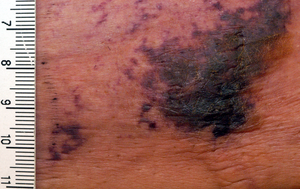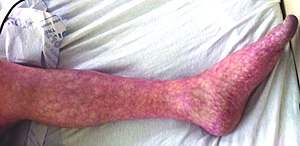Calcifylaxis
Calcifylaxis is a rare life-threatening syndrome that leads to calcium deposits in the media of small and medium-sized arteries. As a result, ischemia and the appearance of painful skin lesions. Calcifylaxis most often occurs in patients dialysed for chronic renal failure (eremic calcifylax), but also in patients with slightly reduced or normal renal function.
Etiology and risk factors[edit | edit source]
The pathogenesis of the process remains unclear. Probably, in conditions of uremia and inflammation, there is a violation of calcium-phosphate metabolism, for example, a decrease in extraskeletal calcification inhibitors (MGP, Fetuin-A). Although risk factors include such common conditions as chronic renal failure with hyperphosphatemia, secondary and tertiary hyperparathyroidism, increased vitamin D intake, the prevalence of calcifylax remains low (1-4% of patients with chronic renal failure).
Clinical picture[edit | edit source]
On the skin of the legs, acres, in the abdomen and hips there are painful lesions of the character livedo reticularis. In later stages, exulcerations and necrosis occur. Calcification of blood vessels arises not only in the skin, but also in other organs, for example, calcifications in lung tissue are a common finding.
Differential diagnosis[edit | edit source]
- Vaskulitis
- Pyoderma gangrenosum
- Leg ulcer
- Embolism of atheroma masses
Therapy[edit | edit source]
Conservative treatment[edit | edit source]
Quality analgesia, wound care and sepsis treatment are essential. Withdrawal of vitamin D therapy, efforts to reduce calcium and phosphorus levels. Treatment of hypercoagulant condition requires discontinuation of warfarin and transition to LMWH. Antibiotic treatment in exulcerations and inflammations. Effective is intravenous treatment with sodium thiosulfate.
Surgical treatment[edit | edit source]
In advanced cases, surgical treatment of exulcerating mornings is performed. Parathyroidectomy may be beneficial in patients with secondary or tertiary hyperparathyroidism.
Dietary measures[edit | edit source]
Trying to supply enough nutrients. Emphasis is placed on limiting phosphorous in the diet.
Forecast[edit | edit source]
Due to superinfections of skin lesions, there is a high risk of transition to sepsis with a total mortality rate of around 80%.
Links[edit | edit source]
Related articles[edit | edit source]
External links[edit | edit source]
Calciphylaxis on Medscape (přístupné po přihlášení)
Source[edit | edit source]
STEDDON, Simon – CHESSER, Alistair – CUNNINGHAM, John. Oxford Handbook of Nephrology and Hypertension. - edition. OUP Oxford, 2014. 944 pp. ISBN 9780191502972.
NIGWEKAR, Sagar U. – KROSHINSKY, Daniela – NAZARIAN, Rosalynn M.. Calciphylaxis: Risk Factors, Diagnosis, and Treatment. American Journal of Kidney Diseases. 2015, y. 1, vol. 66, p. 133-146, ISSN 0272-6386. DOI: 10.1053/j.ajkd.2015.01.034.


